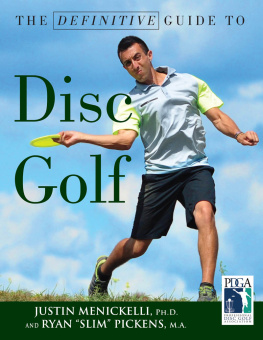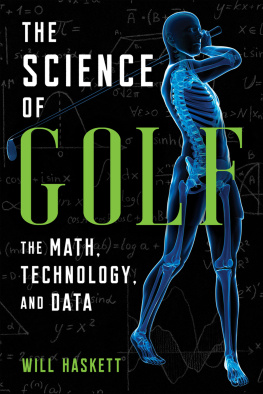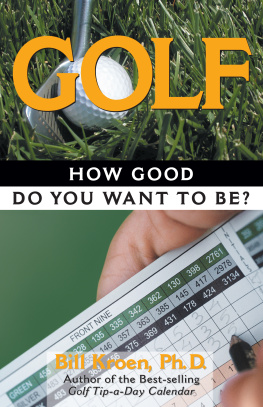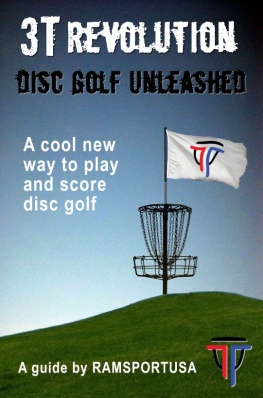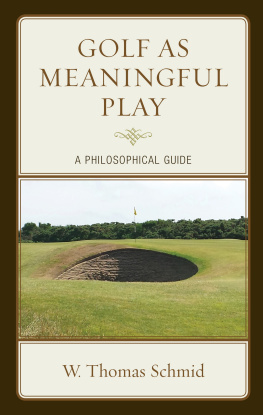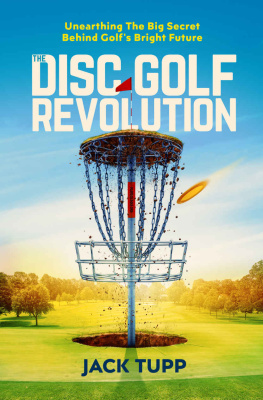
This book is dedicated to Kristin, Aidan, Noah, Addison, Kelly, and Ellora Don.
Contents
Preface
What Makes Disc Golf a Great Lifetime Sport?
For people just starting to play, disc golf may become an outdoor sport they can enjoy for a lifetime. Mark Twain ostensibly referred to traditional golf (played with a little white ball) as a good walk spoiled. We like to think of disc golf as a good walk defined, because it can be appreciated by people of all ages and ability. Men and women, boys and girls can exercise and socialize during a round of disc golf. Avid disc golfers often find playing a challenging test of both physical skill and mental determination. Much like playing traditional golf, the physical and mental challenges great disc golf courses offer are not only enjoyable, but positively addictive.
There are many qualities that make disc golf appealing. For one, playing disc golf is a much less time-consuming alternative to traditional golf. It is also a greener sport than most, as it does not require devastation of natural resources or use of pesticides. Disc golf is an inexpensive lifetime sport; compared to other sports, the start-up cost is minimal. After all, you can play with a si ngle disc that c osts about $10. Most of the 4,000 or so disc golf courses in the US are open to the public and free to play. There is a lot of debate over whether or not pay-to-play is the future of the sport, but for now, it is hard to beat free.
In addition to all those positives, playing disc golf is a healthy form of exercise. We know this, in part, because we conducted a nationwide study to discover if playing disc golf was a way for people to walk 10,000 steps a day, the amount recommended to maintain a healthy cardiovascular system. We discovered that each time people venture outside to play disc golf, they take an average of just more than 6,000 steps. Combine a few hours of disc golf with the 5,000 or so steps the average person already walks each day, and we can reap the benefits of sustained, low- to moderate-intensity aerobic exercise. A working heart is a happy one.
Why This Book?
Much more than just a basic how-to, we think readers will find this book a thoughtful, fascinating, and thoroughly enjoyable exploration of the nature, science, and skills of disc golf. After reading dozens of books about archery, backpacking, badminton, boating, bowling, cycling, fishing, golf, running, skiing, swimming, tennis, and Ultimate, we were inspired to write a comprehensive book about disc golf that would be enjoyed by all players, from absolute beginners to aspiring professionals. There is a lot of information (some of it incorrect or confusing) about disc golf on the Internet. We made it our mission to present technical and accurate content written in a casual voice. Our goal was to write engaging prose that begs to be read cover to cover, and to provide readers with a helpful resource that warrants keeping a copy close by to reference.
We had the privilege of speaking with hundreds of amateur and professional players, course designers, teachers, tournament directors, equipment manufacturers, and living legends of the game. It was a real learning experience for us, and we tried to share this unique perspective throughout the book. Readers may sense a regional bias in some chapters. Although we have played courses and tournaments across the US and the world, we are lucky to live in western North Carolina, a great place to play disc golf, and we could not help but let this shine through in this book.
Acknowledgments
From Justin: I would like to thank all the members of the Catamount Disc Golf Club in Cullowhee, North Carolina, especially Eric Romaniczyn, Clark Lipkin, Andrew Judson, Mike Faust, and Drew Cook. Thanks to all the great people in the WNC Disc Golf Association, including Chris Tuten, Nate Kellar, and James Nichols. Thanks to the EDGE crew: Jay Reading, Des Reading, David Shope, and Jon Lyksett. Thanks to David Claxton, Chris Cooper, Dan Grube, and my students from Western Carolina University. Last, thanks to my family (especially Kristin) and friends who helped make this project a success.
From Ryan: I would like to thank the talented crew of players who helped create Seven Oaks, Two Rivers, and Cedar Hill disc golf courses in Nashville, Tennesseeespecially Tuna, Johnny, Ben, Ken, Bob V., Brett, and Farm Fresh. Thanks to all the members of both the WNC Disc Golf Association and the Lakefront Disc Golf Association who, through countless hours of volunteer work, have truly made the western North Carolina / eastern Tennessee region one of the best places to play disc golf in the world.
Thanks to the countless players over the years whom I have had the pleasure to know and who have helped me understand a thing or two. Thanks also to the legend, Ted Williams, who reminded me that God is always on t he fairway, and to my longtime doubles partner, Eric Marx, who frequently demonstrates that age does not dictate your score and that whining while winning is pretty annoying. I love you, Marx. Thanks to my late friend Jerry Harmon, who showed me the elevator putt worked and that pouring tee pads i s not for the weak. Thank you, Jerry. Thanks also to all my fierce competitors who execute shots that are truly special to witness; you have taught me that losing can still be fun. Last, thanks to my parents, wife, and best friends, who have always believed in me and provided support, which has helped make both this book and my life success.
From Justin and Ryan: We would both like to thank the folks at the Professional Disc Golf Association, especially Dan Stork Roddick, for their tremendous support and endorsement of this book. Thanks also to the photographers, the manufacturers that provided photographs, and to the photographic models. Last, thanks to hundreds of players, fans, course designers, tournament directors, and legends of the game for giving their time to be interviewed.
Part I. The Nature of the Game

Sara Nicholsons approach throw on hole 14 of the Steady Ed Headrick Memorial Course at the International Disc Golf Center in Appling, Georgia. Photo courtesy of PDGA Media
1. Getting Started
Technically, the proper name of the sport is disc golf, although some people call it Frisbee golf or, oftentimes in jest, frolf. The primary goal of disc golf is a simple one: to complete the course in the fewest number of throws possible. The basic rules, strategies, and lingo in disc golf are similar to those of traditional golf. In fact, we have lengthy conversations with colleagues who are avid traditional golfers, and if you were to eavesdrop on our dialogue, you would have no idea we were talking about different sports. Terms like course , hole , par , bogey , birdie , putt , drive , fairway , and green are common to both.
Players may choose to compete against other people, but in the end they really just total their number of throws and compare it to the number of throws other players needed to complete the same course. There is a great deal of strategy involved, but very little of it has to do with what fellow competitors are doing, except during the last few holes of tournament play. Some engaging competition can bring out your best possible game, but strategizing your way around a disc golf course is primarily about personal shot selection, which we will talk about in upcoming chapters.
Disc golf is considered a lifetime sport because people often play well into their seventies. It is an individual lifetime sport and differs from dual lifetime sports in the basic cognitive strategies used during play. Dual lifetime sports are those you perform with just one other person (the person against whom you are competing) or with a partner against another pair. Dual lifetime sports include racket sports (e.g., tennis, badminton, squash, and racquetball) and combat sports (e.g., judo and fencing). When playing dual lifetime sports, your opponent may dictate your skill execution, especially if you are getting beaten badly. While playing disc golf, your next shot is almost never dictated by anyone other than yourself, as your thoughts and behaviors are all that really matter.
Next page
